Capturing good pictures of whales is among the most rewarding photographic experiences an underwater photographer can have. These majestic and charismatic creatures evoke wonder, and the time spent with them will likely be unforgettable. The environments where you find them, however, along with their sheer size and elusive nature present challenges.
The two key elements to successfully photographing cetaceansare research and preparation. You might be an excellent photographer, but you won’t get any good pictures if you can’t get near a whale or you’re not ready for the moment once you do. To maximize your chances of good encounters and images, consider these basics: where, when, with whom, and how.
Where
You can swim with whales in several places around the world, but the regulations and conditions will vary depending on the location. Dominica is well-known for resident pods of sperm whales, and their regulations are evolving.
Several countries offer swimming with humpbacks. Tonga allows four people and one guide to get in the water with a whale, and you can approach as close as 16 feet (5 meters) and have great photo opportunities when the whales cooperate. The Silver Bank in the Dominican Republic and Moʻorea in French Polynesia allow more people in the water at once, but that can mean more fins, arms, and bubbles in your pictures and more pressure on the whale encounter. Other places, such as the Revillagigedo Islands, may have opportunistic encounters but often depend on the season.
When inquiring about possible whale destinations, be sure to ask how many boats operate in the same area, how much time is allowed with the animals, and how many people are allowed in the water.
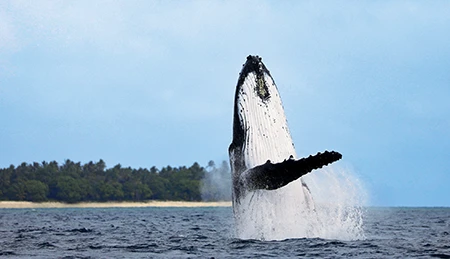
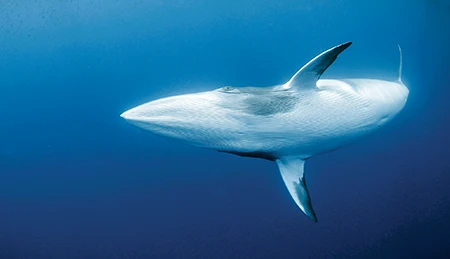
When
Swimming with whales is often a seasonal activity, as many whale species migrate. Timing will vary depending on the location and species. Planning for the middle of the best season at your destination is usually the most reliable.
Whales typically arrive in Tonga in mid to late June, and most will stay for three to four months. Humpbacks usually arrive in Moʻorea by July and stay through November, while January through May is the most productive time on the Silver Bank. The sperm whale population in Dominica swells for mating and birthing from November through March.
With Whom
It is essential to book your whale swimming tours with licensed operators. Their crews are trained on the regulations and best practices and know how to approach the whales. You may also want to book with a photographer who has experience with your desired whale species, as that person will be able to read the animal’s behavior and anticipate its likely movements, which will be invaluable for the encounter.
Let the photographer know if you have a dream shot in your head. If they see that the animals are moving in a way that is conducive to your vision, they can let you know and help position you.
Unfortunately, it is not unusual to find people unwilling to follow the guide’s directives about a benign approach to the whale, which can distract from the overall harmony of the experience. Likewise, it is important that the in-water guide does not compete with guests for the best shot, which can also create conflict. The tour operator will carefully explain how you are allowed to swim toward a whale, if at all, and an overly aggressive approach from anyone can ruin an encounter for everyone.
It’s essential to understand that there is no way to know at what time you will see the whales or how many you will see and for how long. There is no guarantee you will swim with them at all. Any operator who tells you otherwise is probably not following ethical practices.
Some places have untrained operators who offer illegal swimming with whales, which often results in the whales being crowded and harassed. These operators’ boats might not be suitable for open-ocean activities and lack appropriate safety equipment, which is potentially dangerous when at sea. There is also the risk of being arrested when working with unlicensed operators.
The real bottom line is that no image is worth compromising the whale’s welfare. Make sure you work with a licensed, experienced operation and that all required permits are in place.
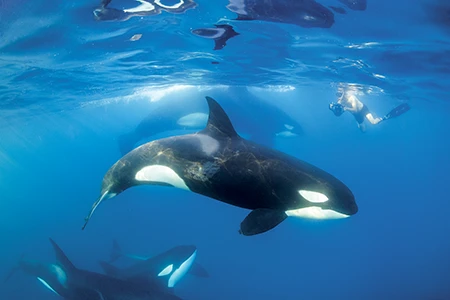
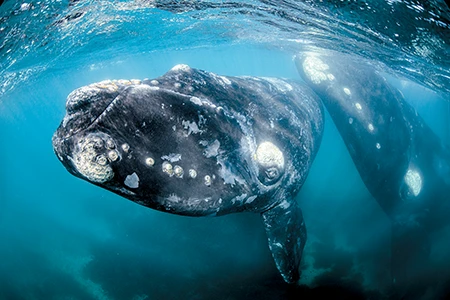
How
As mentioned earlier, the number of people allowed in the water is a crucial point to consider. In addition, try to book several days on the water to maximize your chances of good swims and opportunities to see different behaviors. Each day and each encounter is likely to be different, even with the same animal. Whale swimming activities often occur during the winter months, when there are more robust prevailing winds, so having a few days as a buffer for bad weather helps. It will also give you a chance to practice and get used to being in the presence of whales. Book as many days as your budget and schedule allows.
Most whale swimming activities are done while snorkeling, so it’s paramount to feel comfortable in the open ocean, where there is often swell and you can’t see the seafloor below. One of the main challenges of photographing whales underwater is getting in the right position for the shot. I recommend anyone joining me be fit enough to start their in-water approach from quite a distance so the animals get used to them.
Being comfortable and physically prepared will get you where you need to be and allow you to enjoy the experience longer. Getting fit is also helpful if you are lucky enough to meet a curious youngster. Some can be very inquisitive toward people and will come in for a close look. They can be clumsy or pushy at that age, so it’s handy to be able to move fast.
It is also good to practice kicking without splashing, as the in-water approach needs to be as quiet and smooth as possible. Having a buoyant housing reduces the drag and makes it easier to swim. It also gives me peace of mind to know that it’s not going to sink if I accidentally let it go. Most housings, however, are negatively buoyant by design.
Carefully consider what you wear based on the conditions. Ask your tour leader what the water temperature will be and assess what that means for you. Some people will wear a dive skin in 75°F (24°C) water, while others will be in a 5 mm wetsuit. The 5 mm wetsuit will be warmer, but you’ll need more weight to overcome the suit’s buoyancy. If you are lucky to encounter a relaxed whale, you could be in the water for a while, so it pays to be well-prepared with your gear so you don’t have to go back to the boat because you are cold. I always use layers that I can add or remove as needed. Remember to have protective clothing for wind, rain, or sun if you want to take surface pictures from the boat.
Technical Considerations
It’s essential to know your equipment. Refamiliarize yourself with your camera and housing before the trip. Whales can quickly change position, and you don’t want to miss the shot because you were busy changing the settings. Establishing your settings before entering the water is a good idea, especially since the first few times seeing a whale can be quite overwhelming.
Settings: I generally prefer using shutter-speed priority automation and setting the ISO before entering the water based on the surface light conditions (strobes are usually not allowed with whales). A shutter speed between 1/200 second and 1/400 second works well for me with relaxed whales. My ISO will usually be 200 or 320 on a bright day, or I will push it to 800 on a dark, overcast day.
I select fast, continuous shutter shooting; if your camera has the option, use the mode for shooting moving subjects (for example, Al Servo mode in Canon or AF-C in Nikon cameras). LCD screens can be misleading, so check your histogram to ensure your exposure is fine.
I use autofocus target with nine focus points and place them left or right of the center of the display, depending on the direction in which the whales are swimming. That way I’m likely to be in focus where the head of the whale will be.
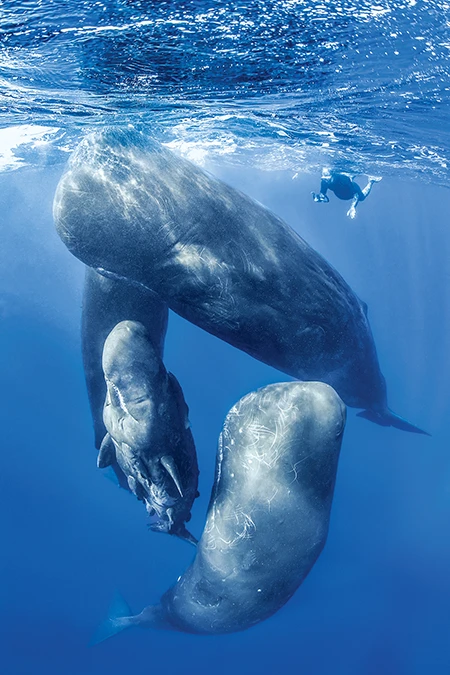
Shoot in RAW format, if you can, for a wider range of options in postediting.
Lens preference: I typically use a 16-35mm lens on my full-frame camera for versatility. Try to get as close as you can while respecting the animals and keeping a safe distance. Being close is key to getting good, clear shots. If I have to zoom more than 20mm, I’m probably too far away, and the amount of water between me and the subject will reduce the level of detail.
For larger whales, such as Southern right whales, or those likely in social groups, such as sperm whales, an 8-15mm fisheye zoom lens is convenient.
Action cameras: It’s also nice to have great video captures of your time with whales. You may want to attach a small GoPro or DJI action camera to your housing. If you can mount it so it has about the same field of view as your still camera lens, you can let it run and then edit the footage later. This allows you to concentrate on stills while also having a video record of the encounter.
Ecological Considerations
I like to shoot from the side, as that angle allows me to capture the whole animal and the eye, and it means that I’m in a safe position and not crossing the animal’s path. Front-on shots are nice, but don’t attempt it if the animal is on the move.
If the animal is resting and relaxed, confirm with your guide that it is OK to approach from the front. Approach slowly — being patient and predictable in the water will make the animal comfortable with your presence, which is conducive to a better, longer encounter.
If you have a second camera body available, it’s well worth bringing it with a telephoto lens for topside photography. Surface activity can be phenomenal, especially if you come across a playful humpback calf learning how to breach. A 100-400mm zoom lens works well for many whales, except for Southern right whales and gray whales, which can be quite curious and approach near the boat. You will need a fast shutter speed to capture a sharp breach, especially when on a moving boat, so I often use 1/1500 second to 1/2000 second.
When it comes to equipment and preparation, make sure your gear is in good working condition before leaving for your trip. Bring spare O-rings and batteries, as whale swim activities often take place from liveaboards or remote areas.
Please remember that the pictures you see online and in magazines are among the photographers’ best work and often have been taken over many days, weeks, or even months. For each great picture, there are many average ones.
As a tour leader, I occasionally have guests with high expectations because of what they see online. They sometimes don’t fully enjoy the experience because they are so focused on getting the shot. Remember to be patient. Following these tips will maximize your chances of good encounters and pictures, but there is no way to guarantee any outcomes with wildlife, especially megafauna.
Enjoy the moment, and look away from your camera at times. Spending time with these gentle giants is a wonderful, sometimes life-changing experience. Even though you might not get award-winning shots, the images in your memory will stay with you forever.
© Alert Diver – Q4 2024